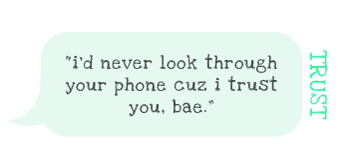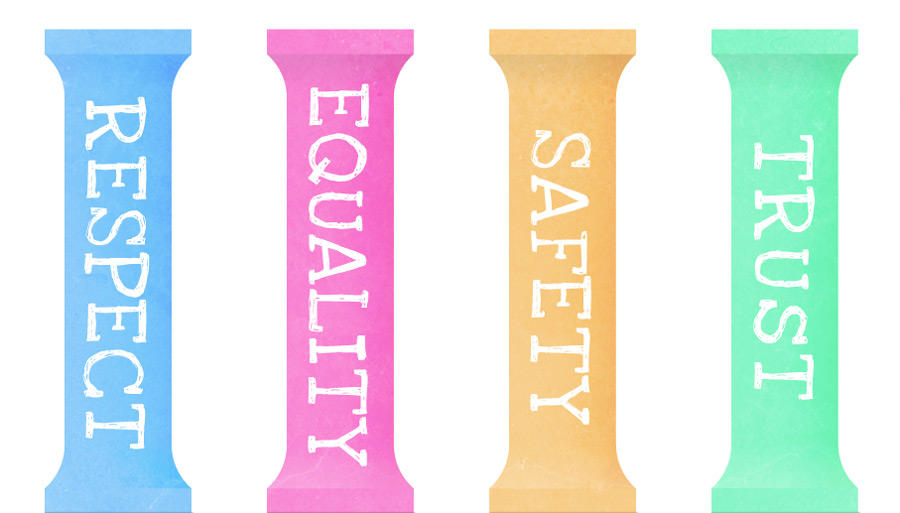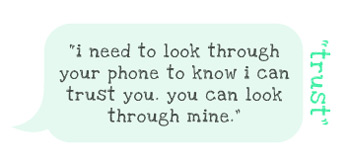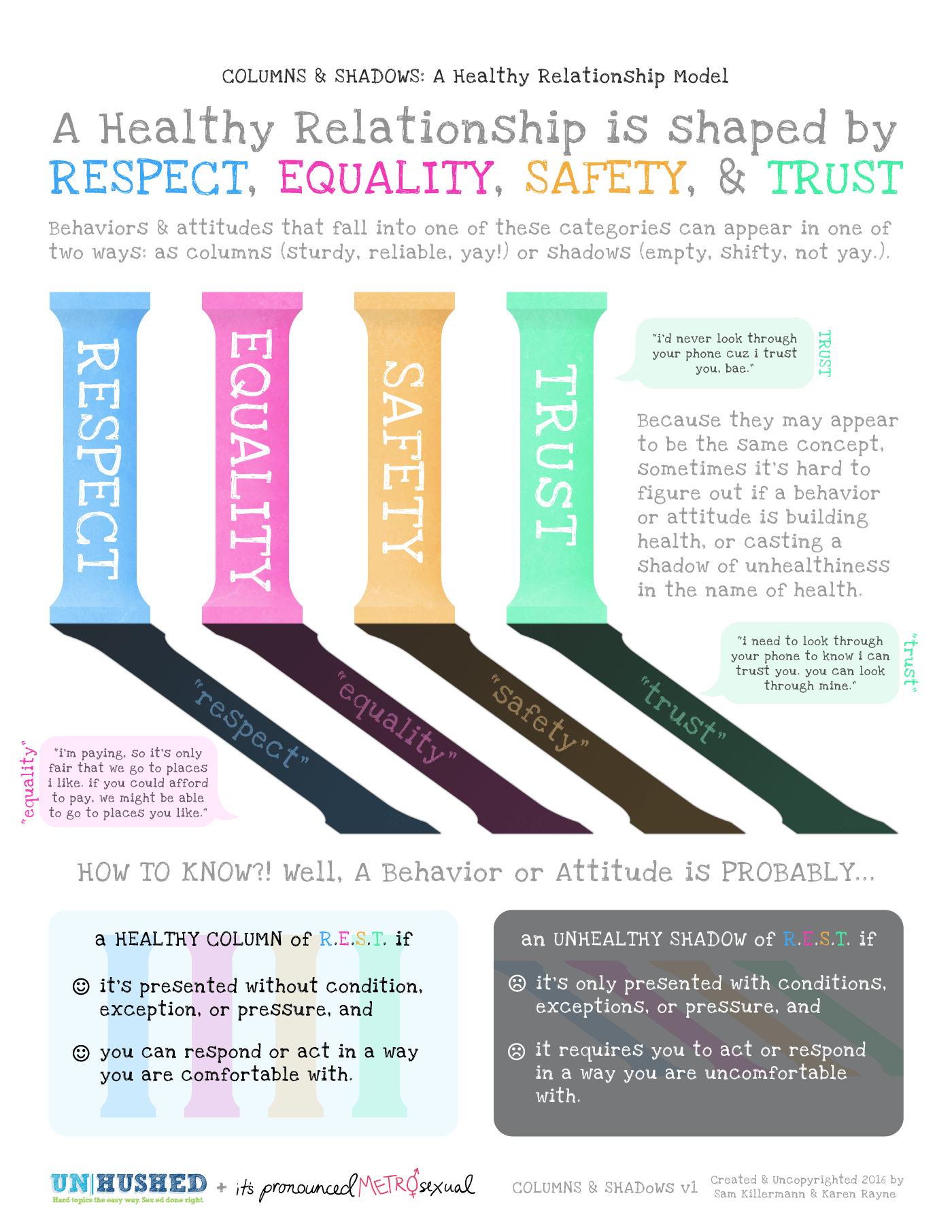It’s hard to define what a healthy relationship looks like because we all navigate relationships differently. Relationships are generally seen through the lenses of our gender as well as our sexuality, but there are many other aspects of our identity that are going to inform what we see as good or bad, desirable or detestable, healthy or unhealthy.
It’s not as simple as “don’t be a jerk” (although that’s a great starting point).
Because of that complexity, it might be easy to throw in the towel and say “there’s no such thing as a universally healthy relationship.” I won’t disagree with that (we’ll discuss it later), but I will suggest that there are four elements that are required _for _a healthy relationship. That is, they’re not sufficient (these things alone won’t do it), but they are necessary. What’s more, I would argue that these same four things can lead to a relationship that is fundamentally unhealthy, as much as they can build up a healthy one.
Unlike being a jerk, which is more of a one-dimensionally bad way to be.
When building relationships, the materials we use are important, and the ways we use those materials are just as important. Without further ado, here are four things that are needed for a healthy relationship: respect, equality, safety, and trust. Each of these components can manifest in healthy ways or in unhealthy ways in any relationship, and are built with actions as much as words. Following is the explanation behind a healthy relationship model that I co-created with Karen Rayne of Unhushed.
Let’s Start with the Components: R.E.S.T.
We’ll discuss the different ways these things appear in our relationships in a second. First, let’s make sure we’re on the same page about what they are.
Respect is…
Here, we’re talking about the definition of respect being similar to “a feeling or understanding that someone or something is important, serious, etc., and should be treated in an appropriate way.”
Respect is about appreciating your partner(s) viewpoints, opinions, beliefs, and decisions — both in general, and regarding your relationship. It’s about setting and observing boundaries, hearing your partner when they say “Yes,” “No,” or “Maybe,” and making sure you ask for their input to begin with.
And respect is about recognizing the importance of the relationship you’re in. Following the guidelines you’ve set up for each other, treating the relationship with care, or at least the amount and type of care that you know is expected by your partner(s).
Equality is…
Here, we’re talking about the definition of equality of “being equal, especially in status, rights, and opportunities.” Take special note here that I’m using the word equality (instead of my generally-preferred-in-social-justice-context “equity”) intentionally. We aren’t looking for fair amounts of access, but a truly balanced amount of power amongst the people in the relationship.
Equality is about making decisions together, or at least creating agreements for how decisions will be made. It’s about your partner(s) having the same amount of voice and power, and knowing that the partners in a relationship have an open seat at the decision-making table (even if they don’t choose to sit in it).
This can be tough, because everyone is navigating the very unequal world-at-large with different amounts of power (some of us granted more, others less, because of our social identities), so it’s easy for us to slip into either recreating those dynamics in our relationships, or inverting them to a different harmful outcome.
Safety is…
Here, we’re talking about the definition of safety of “the condition of being protected from or unlikely to cause danger, risk, or injury” with one big caveat: _at the cause or negligence of your partner(s). _That is, a healthy relationship doesn’t require safety from the elements, a crashing economy, or an errant banana peel. It’s safety with and from each other in the relationship.
Safety is about knowing that your partner(s) won’t intentionally hurt you — physically, emotionally, psychologically, or otherwise. It’s knowing that they are looking out for you, for your interests, and for your general well-being.
You’re not going to be able to protect each other from everything, but if you fall their way they’ll catch you.
Trust is…
Here, we’re talking about the definition of trust similar to “the belief that someone or something is reliable, good, honest.” A mutual trust that the partners in the relationship can believe one another, rely on one another, and be generally good to one another.
Trust is about knowing that you can believe your partner(s), that they are saying what they mean, and that when they act you can reasonably assume they’re acting in ways that are good. It’s knowing that you aren’t being manipulated, mislead, or taken advantage of.

Healthy Versions of R.E.S.T. are Columns
Think of the imagery of a column: solid, sturdy, physical, and something upon which other things can be placed. Healthy versions of respect, equality, safety, and trust pop up in our relationships like columns.
You might create these columns with behaviors or attitudes, with actions or with kept promises. Showing genuine interest in your partner’s job or interests can build respect. Allowing everyone to get as much say as they want in what movies you watch or meals you eat can build equality. Safety can be created by looking out for a partner when they’re vulnerable. And trust is built when your words align with your actions.
 We can imagine every interaction in our relationship — every action, every promise, or every value — that adds to respect, equality, safety, and trust as a brick in a column. Or every possible interaction as a potential brick, waiting to be added over time (or not added) to a relationship.
We can imagine every interaction in our relationship — every action, every promise, or every value — that adds to respect, equality, safety, and trust as a brick in a column. Or every possible interaction as a potential brick, waiting to be added over time (or not added) to a relationship.
How many actions, promises, or values of R.E.S.T. constitute a “healthy” relationship is up to the people involved. There’s no quota, no “you must be this tall to ride.”
And, as I mentioned above, building columns of R.E.S.T. is not necessarily _enough _for a healthy relationship. Some people will need more and distinctly different things to be healthy. But the odds are good that these four components will be required, in some form or fashion.
As a general rule, a behavior or attitude is probably a healthy column of R.E.S.T. if it’s presented without condition, exception, or pressure, and you can respond or act in a way you are comfortable with.

And Unhealthy Versions of R.E.S.T. are Shadows
Consider the imagery of a shadow: shifting, unreliable, visual, and more of a lack of something than something at all. Unhealthy versions of respect, equality, safety, and trust pop up in our relationships like shadows.
These shadows might be created by behaviors or attitudes, by action, inaction, or insincere promises. They’re the things you know you should be doing, but aren’t. They’re the actions that look like, or sound like, or are sold as something good, but feel terrible. Sometimes, it’s easy for us to mistake them for columns, because they bear the same shape; or for us to hold onto the shadow of a column we used to have in our relationship, hoping it will return.
 A shadow version of respect might be talking differently about your partner(s) to other people than you would talk about them to them. A shadow version of equality might be saying that it’s only fair that one partner makes this decision, because they make more money (or have a harder job, or have it tougher at school, etc.), without asking or agreeing upon that arrangement. Shadow safety might look like someone telling their partner they don’t want them going out alone, and accompanying them everywhere without their inviting. And shadow trust might be forcing your partner(s) to unlock their phone so you can read their texts.
A shadow version of respect might be talking differently about your partner(s) to other people than you would talk about them to them. A shadow version of equality might be saying that it’s only fair that one partner makes this decision, because they make more money (or have a harder job, or have it tougher at school, etc.), without asking or agreeing upon that arrangement. Shadow safety might look like someone telling their partner they don’t want them going out alone, and accompanying them everywhere without their inviting. And shadow trust might be forcing your partner(s) to unlock their phone so you can read their texts.
Sometimes, a shadow will pop up as a byproduct of a column that we have in our relationship (e.g., something good creates something bad); other times it’ll appear by itself, a relic of something healthy that might appear in some other relationship.
Recognizing how a behavior, value, or statement appears in your relationship — whether it falls into the categories of R.E.S.T. or not — and not just taking it at face value, is important for identifying what’s healthy or unhealthy.
As a general rule, a behavior or attitude is an unhealthy shadow of R.E.S.T. if it’s only presented with conditions, exceptions, or pressure, and it requires you to act or respond in a way you are uncomfortable with.
![rest-shadows-by-sam-killermann-karen-rayne]() The Makings of a Healthy Relationship
The Makings of a Healthy Relationship
So what do we do? None of the above is a blueprint; it’s more of a rubric. The idea that healthy relationships have positive manifestations of respect, equality, safety, and trust doesn’t tell you much about how to make those things happen, as much as it tells you how to gauge what’s happening.
Know that we all have a different blueprint for healthy.
How we navigate the things above (what’s respectful, equal, safe, or trustworthy), is going to depend on who we are. But knowing that there are healthy and unhealthy ways similar ideas can appear in our relationship will, hopefully, give us a better sense of what’s good for us and what’s bad for us.
And this is the start of the conversation, not the end.
These concepts are meant to get you thinking, talking, and hopefully sorting out for your own sake what is and what isn’t healthy in a relationship — for you. Or for you to start that conversation with someone else. Hopefully, the ideas that respect, equality, safety, and trust are components of a healthy relationship, and that negative versions of them (the shadows) often masquerade as components of a healthy relationship, are helpful to begin a dialogue — internal or external.
Feel free to play around with these ideas, and with this model in general. At the very least, I hope that even if you disagree, the disagreement can foster some health in your life. And if you agree, I hope that you can use this model to build upon, or start, a healthy relationship in your life.


 The Makings of a Healthy Relationship
The Makings of a Healthy Relationship